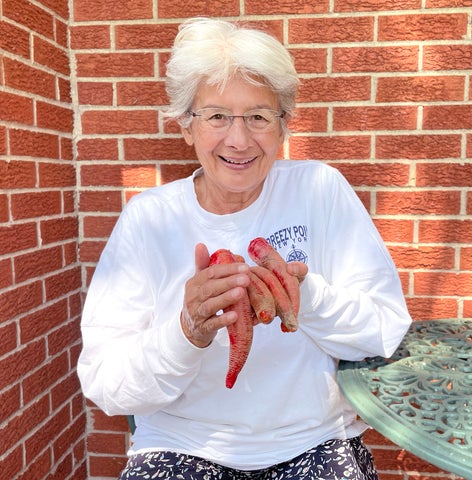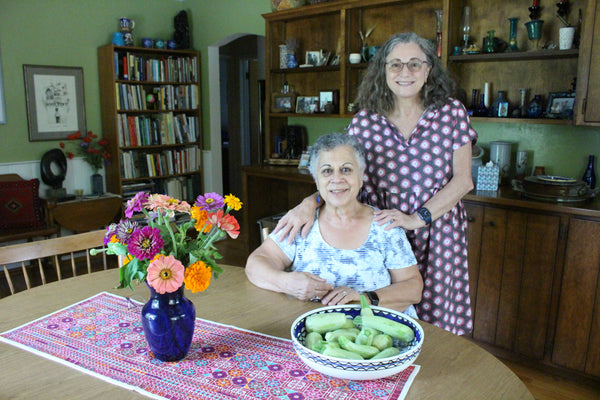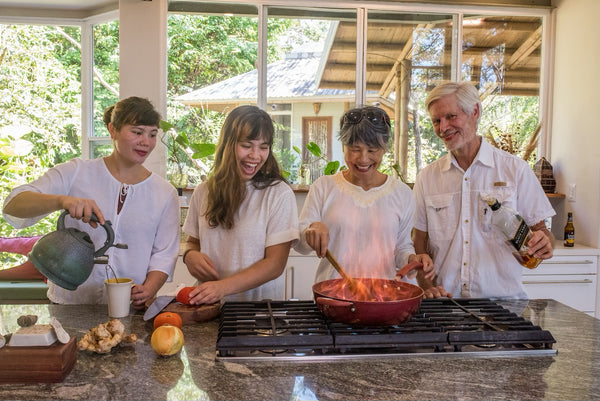This December, I sat down with fellow mushroom hunter and farm friend Smilka Zdravkovska, and her daughter, Bojana (Bo-ya-nah), to chat about the Macedonian Embroidered pepper, an ancestral seed for their family. Bojana had recently flown in from the Balkans, and when I came over to Smilka’s house, she was curled up on the couch with a blanket and a smile. Smilka welcomed me in and brewed a hot cup of tea for us all as we settled into our respective couches for a good, long conversation. We prepared ourselves to journey from the intricacies of growing and using this pepper, all the way to the significance of their ancestral seeds and beyond.
Macedonian Embroidered peppers, called Vezena piperka in Macedonian, are named in reference to their distinctive, knitted thread-like pattern on their skin, which gives them a very unique appearance. They are about 5-6” long and ripen from green to red. Most people don’t know that all peppers (excluding black pepper, which is another species) originated in the Americas, and were domesticated from wild plants by indigenous Americans. During European colonization (around 1500 AD), pepper seeds were brought back to Europe and then eventually made their way to the rest of the world. They soon became an essential element of international cuisines, including Macedonian/Yugoslavian cuisine.
To orient readers unfamiliar with the geography of Eastern Europe, Macedonia (officially called the "Republic of North Macedonia") is a country in Southeastern Europe just north of Greece. Until 1991, it was one of the six republics that formed the larger country Yugoslavia. It is known for its scenic mountains, lakes and rivers.

The Macedonian Embroidered pepper is considered a “landrace” type, which means that various strains of the variety were developed by many different local communities in a specific place. Because of this, there is an extraordinary diversity of fruit size, shape and taste. On average, they’re a level or so hotter than a jalapeño, but different strains can range from mild to sometimes quite hot. They have a lovely, rich flavor. According to Smilka and Bojana, strands of these peppers threaded together and hung out to dry on the sides of houses are a common sight across Macedonia. Though the peppers can be used both fresh and dried, the hot and sunny climate there is perfect for drying them out so that they can be preserved for the winter season.

Pictured: Macedonian hot peppers hung out to dry at a farmer's market in Macedonia
Smilka explains with a warm smile that, throughout the years, she has cooked using all sorts of cuisines from around the world, but always comes back to the traditional Yugoslavian recipes that she learned from her mother and grandmother. Growing up, Smilka traveled a lot with her family, due to her father being a diplomat. They moved from Skopje (the capital of the Republic of Macedonia within Yugoslavia), where Smilka was born, to Finland, France, and Lebanon. But in addition to being exposed to many different European cuisines over the years, Smilka has fond memories of learning about her ancestral foods from her mother, and from other members of her family, as well.
After a series of moves in her adult life which culminated in her acquiring her PhD and becoming a Professor of Mathematics, Smilka eventually settled in Ann Arbor in 1980, where she worked as an Associate Editor of Mathematical Reviews and occasionally taught Mathematics at the University of Michigan for over 30 years. She retired 10 years ago. Within the first few years of moving to Ann Arbor, she created her own vegetable garden, which she couldn’t do all those years she was itinerant; finally, she was able to grow her own food. Despite having a shady yard, she was determined to have a garden, so she created her very own edible garden in her front yard. She laughs when she tells me that “in 1984, people were like ‘you don’t put [a] garden in the front lawn!’” But she didn’t care; she wanted her peppers, her tomatoes, and her herbs, and she wanted them fresh from her own garden.
Smilka has been growing Macedonian Embroidered peppers in her garden for 5 or 6 years now. She’ll save the seeds herself, but every time Bojana and Smilka’s son, Andrej, visit Skopje, Smilka puts in an “order” for fresh seeds. This year, Bojana and Andrej brought back Ajvarki (Ay-var-key) peppers as well, which are even larger than Macedonian Embroidered peppers. Smilka plans to plant these seeds in her garden this coming spring, as well.

Pictured: A crateful of Macedonian Embroidered hot peppers
Ajvarki and Macedonian Embroidered peppers, although similar in appearance, have different uses traditionally. Ajvarki peppers are mainly used fresh, in a spread/relish called “Ajvar,” made of the roasted peppers. Salt, sunflower oil, and sometimes eggplant will be combined with the peppers to make a spread that is lathered on fresh slices of bread. Yes, I can attest that it is as delicious as it sounds, as Smilka was generous and thoughtful enough to share a jar of this sauce with me after our conversation. It was mildly spicy, with a sweetness and creaminess that melted in my mouth.
Macedonian Embroidered peppers, on the other hand, are usually used whole, added as more of a flavoring in bean-based dishes, including the Macedonian National Dish, Tavche Gravche, which is a delicious bean casserole dish that also includes paprika and other spices like bay leaves, garlic, onion, mint, and black pepper. “The basic cuisine in Macedonia is poor people’s food,” says Bojana, “There are many vegetarian and vegan dishes in Macedonia because it’s a poor country, but also, the climate is great for growing vegetables like peppers and tomatoes, because it’s very hot and sunny.” She adds that, because they love it so much and because it is so abundant and easy to grow in this climate, Macedonians will manage to find some way to add Macedonian Embroidered peppers to nearly every dish that they bake in their traditional clay pots. It’s such a foundational flavor in much of Macedonian cuisine, as is paprika, which is more widely used than black pepper because it’s more accessible and less expensive.

Pictured: The Macedonian National Dish, Tavche Gravche, a delicious bean dish flavored with Macedonian Embroidered peppers and other vegetables & spices and cooked in the traditional clay pot.
Another way that Bojana mentions is common to use the dried Macedonian Embroidered peppers is as a spice added to pickled veggies. During the period in which the Ottoman Empire existed, there was a huge intermingling of cultures, and pickling vegetables was a common way to preserve fresh produce from the summer. “The concept is sort of like kimchi,” Bojana says. She’ll take a jar of pickled cabbage, cauliflower, peppers, or tomatoes, and crush embroidered peppers on top before eating. She says that this is a common Macedonian “antipasto”/side dish, and that it’ll usually be accompanied by some sort of strong spirit.
Back in Ann Arbor, Smilka has her own method for processing her Macedonian Embroidered peppers in her garden. After harvesting them, she’ll dry them in her screened in porch. She’ll string the peppers up, threading a string through their stems, and hang them from tables and chairs to dry. Once they’re dried, she’ll add them to bean dishes and casseroles. Similar to a bay leaf, she’ll add the pepper in whole at the beginning, and once the dish has been cooked, she’ll either remove the pepper or eat around it. This way, the pepper’s flavor is a prominent part of the dish, but it doesn’t make the dish too spicy.
Smilka and Bojana both have fond memories of processing the Ajvar peppers as well. Back in Macedonia, when September rolls around, whether in the town or in the surrounding countryside, everyone will buy a big bag of fresh ajvar peppers. They’ll bring it home, make a big fire outside, roast all the peppers, then put everyone to work. Bojana was a mere 5 years old when she started helping out with this. Once the peppers cool, they’ll peel the peppers and take out the seeds. Then, the pepper flesh will be processed through a meat grinder and cooked with some oil and salt. Finally, they are put into sterilized jars put in the oven for a bit so that a small crust forms on top. Smilka and Bojana both remember this being quality family time, and that even though it was a lot of work, everyone in the family and greater community was involved. “The whole city smells of roasting peppers,” Smilka laughs. Bojana mentions her regret that traditions like this have been largely taken away from us in modern life. Being able to simply buy ajvar sauce at a store, although convenient, cancels out the whole Ajvar-making ritual, time that could be spent with family, working together to create something delicious. “There was a different sense of time we had back then,” says Bojana.
Towards the end of our conversation, Bojana begins to wonder about what Macedonian cuisine looked like before peppers were brought from the Americas to Europe during the Middle Ages, despite them being so integral to Macedonian culture nowadays. When we think about ancestral foods, how far back do we go? How many centuries must one culture develop to be considered “ancestral” to those in the 21st century? Which parts of history do we include, and which do we leave out? These are all questions we found ourselves asking as our time together drew to an end. As we continue to dive deeper into the topic of our own ancestral cultures and seed and food traditions, these questions will inevitably come up. But I wonder, in having these conversations, one by one, if we can begin to see a greater story unfold, one that doesn’t really have an ending, but is an ongoing dialogue that we can use to create more and more beautiful stories. This, I hope, is the path that unfolds before us, as we each do this work in our own way, and in our own time.
By Grace Pernecky
P.S. Check out these delicious recipes that feature both Macedonian Embroidered and Ajvarki hot peppers!




